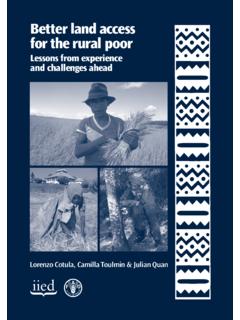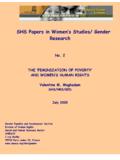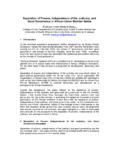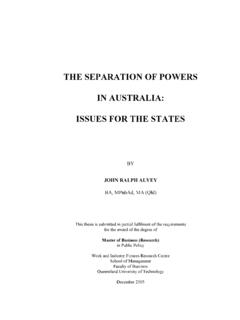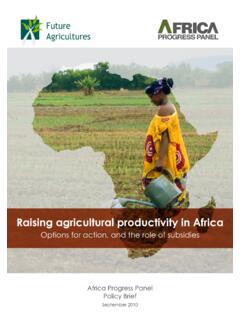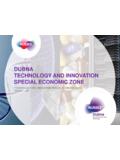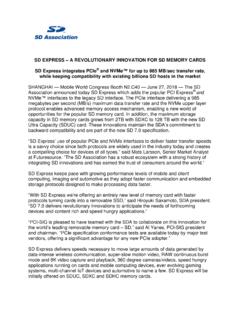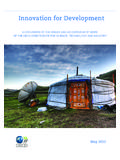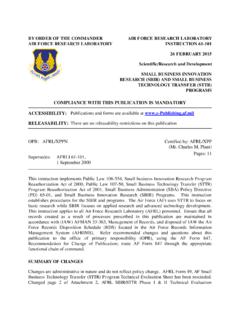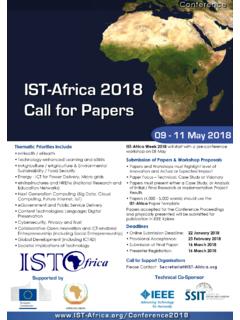Transcription of The Agricultural Innovation Process: Research and ...
1 The Agricultural Innovation Process: Research and technology Adoption in a ChangingAgricultural Sector(For the Handbook of Agricultural Economics)David Sunding and David ZilbermanDavid Sunding is Cooperative Extension Specialist, Department of Agricultural andResource Economics, University of California at BerkeleyDavid Zilberman is Professor, Department of Agricultural and Resource Economics,University of California at BerkeleyRevised January , 2000 Abstract: The chapter reviews the generation and adoption of new technologies in theagricultural sector. The first section describes models of induced Innovation andexperimentation, considers the political economy of public investments in agriculturalresearch, and addresses institutions and public policies for managing Innovation second section reviews the economics of technology adoption in models, diffusion models, and the influence of risk, uncertainty, and dynamicfactors on adoption are considered.
2 The section also describes the influence ofinstitutions and government interventions on adoption. The third section outlines futureresearch and policy : Innovation , diffusion, adoption, technology transfer, intellectual propertyDavid Sunding: tel: 510-642-8229; fax: 510-643-8911; email: Zilberman: tel: 510-642-6570; fax: 510-643-8911; email: Agricultural Innovation Process: Research and technology Adoption in a ChangingAgricultural SectorTechnological change has been a major factor shaping agriculture in the last 100 years[Schultz (1964); Cochrane (1979)]. A comparison of Agricultural production patterns inthe United States at the beginning (1920) and end of the century (1995) shows thatharvested cropland has declined (from 350 to 320 million acres), the share of theagricultural labor force has decreased substantially (from 26 to percent), and thenumber of people now employed in agriculture has declined ( million in 1920 vs.)
3 In 1995); yet Agricultural production in 1995 was times greater than in 1920[United States Bureau of the Census (1975, 1980, 1998)]. Internationally, tremendouschanges in production patterns have occurred. While world population more thandoubled between 1950 and 1998 (from to billion), grain production per person hasincreased by about 12 percent, and harvested acreage per person has declined by half[Brown, Gardner, and Halweil (1999)]. These figures suggest that productivity hasincreased and Agricultural production methods have changed is a large amount of literature investigating changes in productivity,1 whichwill not be addressed here. Instead this chapter presents an overview of agriculturaleconomic Research on innovations the basic elements of technological and institutionalchange.
4 Innovations are defined here as new methods, customs, or devices used toperform new literature on Innovation is diverse and has developed its own vocabulary. Wewill distinguish between two major Research lines: Research on Innovation generation andresearch on the adoption and use of Innovation . Several categories of innovations havebeen introduced to differentiate policies or modeling. For example, the distinctionbetween innovations that are embodied in capital goods or products (such as tractors,fertilizers, and seeds) and those that are disembodied ( , integrated pest managementschemes) is useful for directing public investment in Innovation generation. Privateparties are less likely to invest in generating disembodied innovations because of thedifficulty in selling the final product, so that is an area for public action.
5 Privateinvestment in the generation of embodied innovations requires appropriate institutions forintellectual property rights protection, as we will see classification of innovations according to form is useful for consideringpolicy questions and understanding the forces behind the generation and adoption ofinnovations. Categories in this classification include mechanical innovations (tractors 1 See Mundlak (1997), Ball et al. (1997), and Antle and McGuckin (1993).3and combines), biological innovations (new seed varieties), chemical innovations(fertilizers and pesticides), agronomic innovations (new management practices),biotechnological innovations, and informational innovations that rely mainly on computertechnologies.
6 Each of these categories may raise different policy questions. Forexample, mechanical innovations may negatively affect labor and lead to farmconsolidation. Chemical and biotechnological innovations are associated with problemsof public acceptance and environmental concerns. We will argue later that economicforces as well as the state of scientific knowledge affect the form of innovations that aregenerated and adopted in various categorization of Innovation according to form distinguishes betweenprocess innovations ( , a way to modify a gene in a plant) and product innovations( , a new seed variety). The ownership of rights to a process that is crucial indeveloping an important product may be a source of significant economic power.
7 Wewill see how intellectual property rights and regulations affect the evolution of innovationand the distribution of benefits derived from can also be distinguished by their impacts on economic agents andmarkets which affect their modeling; these categories include yield-increasing, cost-reducing, quality-enhancing, risk-reducing, environmental-protection increasing, andshelf-life enhancing. Most innovations fall into several of these categories. For example,a new pesticide may increase yield, reduce economic risk, and reduce environmental4protection. The analysis of adoption or the impact of risk-reducing innovations mayrequire the incorporation of a risk-aversion consideration in the modeling framework,while investigating the economics of a shelf-life enhancing Innovation may require amodeling framework that emphasizes inter-seasonal sections on the generation of innovations follow in Part I.
8 The firstintroduces results of induced Innovation models and the role of economic forces intriggering innovations; the second presents a political-economic framework forgovernment financing of innovations; and the third addresses various institutions andpolicies for managing Innovation activities. Part II discusses the adoption of innovationsand includes four sections. The first section considers threshold models and models ofdiffusion as a process of imitation; the second presents adoption under uncertainty; thethird addresses dynamic considerations on adoption; and the last two sections deal withthe impact of institutional and policy constraints on adoption. Part III addresses GENERATION OF INNOVATIONI nduced InnovationsThere are several stages in the generation of innovations.
9 These stages are depicted inFigure 1. The first stage is discovery, characterized by the emergence of a concept orresults that establish the Innovation . A second essential stage is development, where thediscovery moves from the laboratory to the field, and is scaled up, commercialized, andintegrated with other elements of the production process. In cases of patentableinnovations, between the time of discovery and development there may also be a stagewhere there is registration for a patent. If the Innovation is embodied, once it isdeveloped it has to be produced and, finally, marketed. For embodied innovations, themarketing stage consists of education, demonstration, and sales.
10 Only then does Figure 1 Some may hold the notion that new discoveries are the result of inspirationoccurring randomly without a strong link to physical reality. While that may sometimesbe the case, Hayami and Ruttan (1985) formalized and empirically verified their theory ofinduced innovations that closely linked the emergence of innovations with economicconditions. They argued that the search for new innovations is an economic activity that6is significantly affected by economic conditions. New innovations are more likely toemerge in response to scarcity and economic opportunities. For example, labor shortageswill induce labor-saving technologies. Environmental-friendly techniques are likely to belinked to the imposition of strict environmental regulation.
